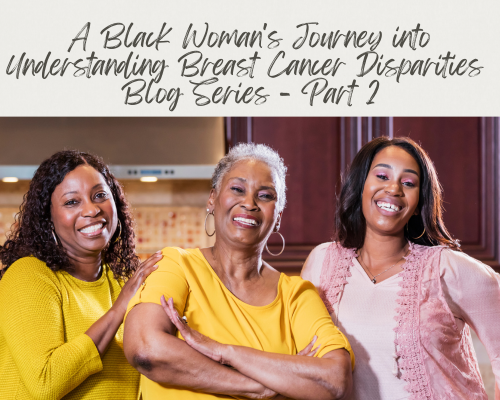
Read the first blog in the series here.
When thinking about why, compared to white women, black women are being diagnosed with harder to treat breast cancer at younger ages, there are a few potential reasons.
The first is one that many activist groups have been actively combating for years: Access to resources.
This country has a tragic history of hoarding resources for some while denying them to others. This is especially true for healthcare. When you think about where you live, think about where the hospitals are set up. Is it just one hospital or are there a lot of clinics available too? Can you easily get an appointment with your doctor or does it take weeks? Months? When you see your doctor, do they know who you are? Do they know your medical history? What about pharmacies? Are there a lot in your neighborhood? Are the medicines too expensive? Healthcare is not just treatment but it is also prevention. With these discrepancies in access and quality of healthcare, it is no wonder we have some discrepancies in cancer diagnoses and outcomes.
Another potential reason for discrepancies in the health of different races of people is regarding the “allostatic load.”
An allostatic load is essentially the cumulative physical wear and tear on a person’s body caused by stress. Living life as a black woman in this country is a wonderful, beautiful existence, but it can also be very stressful. This country has a history of racism and sexism that permeates almost every part of our daily lives. Too much stress can weaken your body. The various daily stressors placed on us simply existing contributes to this discrepancy in breast cancer statistics.
However, that’s not the full story. There is a third explanation for these discrepancies.
We know that some chemicals cause or increase a person's risk of breast cancer. You may have heard of them referred to as carcinogens. One type of carcinogen is known as an endocrine disrupting chemical. These are chemicals that, upon exposure, make changes to your body by disrupting the regulation of hormones. Exposure to these chemicals can come from a lot of different places. The question is: Are black women experiencing a higher exposure than white women? What if our environment is poisoning us?
The current CHDS study I’m working on, “Detect Signs of Early Life Exposures in Midlife to Prevent Breast Cancer Inequities,” explores whether increased allostatic load and exposure to toxic chemicals in black communities is responsible for noticeable changes in hoe our DNA is expressed that lead to an increased risk of breast cancer.
In reality, it is unlikely that there is one single factor that determines why we have these discrepancies in cancer rates and outcomes between black women and white women. Access to care, allostatic load, and environmental exposures likely all play a role. However, the more we can find out about these environmental exposures and their effects, the better we can anticipate the needs of black women regarding breast cancer and the better we can prevent further damage for future generations.
Written by Akilah Shahid, Community Principal Investigator at Child Health and Development Studies



